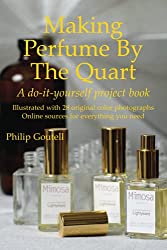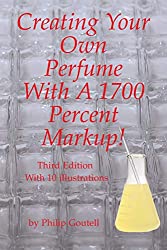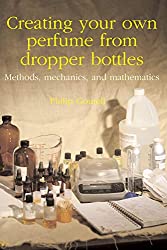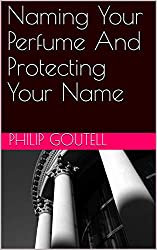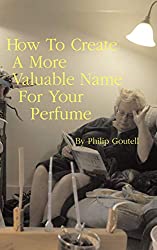Creating perfume with dropper bottles

Shown above: Page from my notebook showing original formula in drops, drops of the original formula multiplied by ten, and the weight of these drops in grams. Also shown is the weight of the bottle in which they were combined ("tare") and the checkmarks made when counting out by groups of 50 drops.
Mixing and weighing can put you to sleep!

A new mixing pot like this one is used for each new trial.
May 21, 2020 — I weighted out the formula for my new perfume. I had finalized the formula in a small, plastic mixing pot. The contents of that mixing pot were 87 drops of aroma materials from seven dropper bottles. Simple. I was pleased with the results so I was ready for the next step which I am describing here.
I needed to make a larger batch for two reasons. First, to be sure I would still be in love with this fragrance as it headed toward a production batch. Second, I had to weigh my ingredients and an 87 drop batch was too small to give me any accuracy. By weighing my ingredients I could calculate the percentages of the formula, by weight, that each ingredient represented. Then, when making my larger batch, I could add each material to the mixture by the required weight rather than having to "drip drop drip" materials from dropper bottles. Follow me as I explain the process.
To start, I multiplied by ten the number of drops of each of my raw materials. This brought the formula up to 870 drops. From experience I know that this volume would be contained in a bottle of 1-fluid ounce capacity, a very standard size bottle for a finished perfume.
I cleared away my desktop and set up my electronic balance, being sure to level it. The model I use has a built-in bubble level and, when each of the four adjustable legs are in correct position, the bubble is centered in the level.
To start the weighing out process, I zero the balance so it reads "0.000," and then I weigh the bottle I'm using to contain the formula. This is called the "tare" weight. I record it in my notebook, Now I begin weighing out the aroma materials. Before weighing each material I zero the balance so that the weight shown will be just for that material. When I've added the required number of drops of each material, I wait for the readout to freeze and indicate that it is showing the correct weight (in grams, to three decimal points but accurate only to two).
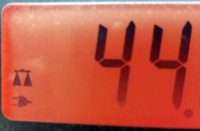
When the "balance beam" icon appears above the "power" icon, the display has stopped moving and the correct weight is now being displayed.
I then record this weight in my notebook. Then I'm on to the next ingredient: zero the balance, drop, drop, drop from a dropper bottle, read the weight and record it in my notebook. I go through this for all seven ingredients of this particular formula.
But here's where it gets dicey

Eyedropper, from dropper bottle
Squeezing out drops from what is, in essence, an eyedropper, can be tedious. It's not bad for the small quantities, for the original batch when for two ingredients the drops numbered just five each and where the most plentiful ingredient, just 25 drops. But multiply that by ten as I did. Now your lowest quantity is 50 drops and the largest, 250. Seems simple enough — until you have to do it. My eyes start to glaze over by drop number 107. My attention starts to wander by drop 205. I begin to wonder if I've lost count. Did the drops I just squeezed out bring me to 40... or was it 60? Am I falling asleep?
For items with 100 or more drops I do them in groups of 50, making a check mark on scrap paper each time I've done another 50. (You can see my checkmarks on the photo at the top of this page.) But I have to remember to make that mark for each batch, otherwise I'll be way off. It's good to take a break between ingredients but I don't dare. I'm afraid if I don't keep going, I might knock over the bottle, or the scale might go dead, or I'll be interrupted and lose my concentration — so I just keep going.
Confirmation needed
I hate to do this but I always do it. Since I could have made a counting error, I'll wait a day or two and do it over again, with another bottle. Then I'll compare the results. If they're close, all is fine. If they're seriously off on one ingredient, I'll do a third bottle. The process can seem painfully boring but it's part of what needs to be done.
Work with care
When you are squeezing out drops from your eyedroppers, try to get the same size drop each time. The rubber bulb should be in good condition to give you good control. But sometimes your fingers get tired and, without meaning to do it, you squeeze out two drops where you only wanted one. Worse still, you squeeze out a drop and a half. Then what?
A high degree of concentration is required. This is a downfall for me. My mind tends to wander and I have to force myself to focus, to get "clean" drops and to count them properly.
Be sure, when you start counting out drops, that you have enough material for the project. It can be very frustrating (and expensive!) to get half way through the last item — and then run out of that material. Then you can't finish what you started. If you can't get more of what you need quickly (and usually you can't!) you may have wasted all of that you've used. Now you may need more of all the materials you're using, not just one.
Accuracy
Developing a fragrance with dropper bottles lacks the precision you would find at a major fragrance house. Careful as you might try to be, your drops won't be 100 percent uniform. Your weights will be close but will not have the precision achieved with an electronic balance costing $20,000 rather than $200.
But ask yourself, is your nose sensitive enough to know the difference? My nose isn't bad but it's not that good. And, face it, your finished fragrance is what it is. If people like it, isn't that enough? While the "dropper bottle technique" may be crude by industry standards, it gives people like you and myself a very good, practical way to create our own fragrances – commercial fragrances – if that is our goal. Customers won't judge us by how our results were achieved but simply by the results – the fragrance – we did achieve.
For supplies used in the development of this fragrance, visit the Vendors section of this website.
Also available in a soft cover edition from Amazon. — or read more about this book.
Homemade perfumes generally lack commercial value, regardless of how wonderful they may be, because their creators fail to record how their perfumes were made. To profit from a perfume, to sell it, to sell the rights to it, or have somebody sell it for you, you must be able to make more of it. To make more you need the formula, the record of how the perfume was made: what materials were used and how much of each material was used. While the formula is nothing more than a recipe, a simple piece of paper, it is the key to unlocking your perfume's commercial potential. With the formula in your hand you have the ability to make a few dozen bottles more or, like the celebrities, tens of thousands of bottles. How to create an international production formula for your homemade perfume is a guide to getting you started on the right foot, correctly documenting everything you do as you are doing it, and then using these notes with some basic mathematics to write a simple, accurate, universal formula for your perfume. Writing formulas for your perfumes can change the way you think about them. With your formulas in hand your creations are no longer "here today, gone tomorrow." Now, thanks to your library of formulas, your perfumes become immortal!
While much is written about perfume – the beautiful fragrances... the beautiful bottles – little is available on the "mechanics" of perfume production – the steps that take place on the "factory floor" where a beautiful vision is turned into a finished product, a "ready to sell" perfume. Now you can experience all of these steps, hands on, by making just one quart of your own perfume. If you follow each chapter and do what you are instructed to do, you will end up with from 8 to 64 bottles of your own perfume, depending on the capacity of the bottles you select. Along this "insiders journey," each step is profusely illustrated with professional color photographs and you'll learn — • Exactly what alcohol you'll need and where to get it • Why you'll want (just a little!) water in your perfume • What type bottles you'll need and why you cannot use others • Why you will use a spray and not a cap • How to fill and seal your bottles • How to label your bottles with the correct information so they will be legal for sale • How to select a name for your perfume that will allow you to acquire powerful trademark rights free. If you are a developer of scents you are encouraged to use one of your own for this project. If you are not a scent creator yourself you'll learn how to get a fragrance oil that is exactly right for this project. Online sources are given for all required supplies and materials. Nothing can hold you back from starting your project immediately!
Perfume is famous for the markup it can achieve, even for a middle market fragrance. While "everybody knows" that perfume costs next to nothing to make (not completely true) the making of it is often considered an esoteric secret. "Creating Your Own Perfume With A 1700 Percent Markup!" details how a 3-person company with no experience created their own fragrance in response to a marketing opportunity that was too good to pass up. The book explains exactly what was done to create a fragrance for that opportunity but it is far more than a history of the author's project. "Creating Your Own Perfume With A 1700 Percent Markup!" lays out every step in the process of creating your own perfume, either as a do-it-yourself project – and without the benefit of automated equipment some compromises and workarounds are required – or full bore professional production under your supervision. Either way you will be producing a quality fragrance at a remarkably low cost. Do you have a marketing opportunity that would be wildly profitable if only you could obtain your fragrance at a ridiculously low cost? "Creating Your Own Perfume With A 1700 Percent Markup!" is the guide you need to do it.
Now when you make your own perfume you can make it fully "commercial" meaning you will be creating a product ready for regular, continuous sales to friends, relatives, and the public! If the fragrance you've made has already won praise, why not share it with others? Some might pay you for it and want it for their web stores or retail boutiques! Creating your own perfume from dropper bottles: Methods, mechanics, and mathematics guides you through steps that can turn your hobby project into a perfume business. Discover how close you are now and how little more you must do to take what you made with essential oils and dropper bottles into a business of your own! For an introduction to this book, watch this video.
You can build a perfume business of your own using this business plan as a guide. By following its detailed strategy you learn to identify motivated groups of potential perfume buyers. Members of these groups are near the tipping point of desire for a new perfume. You don't know these people and they don't know you but you know a marketer they trust, one who does not currently sell perfume and might never think of selling perfume were it not for your approach. Here is where you step in with a professional plan, promotion, and perfume to take advantage of this ripe opportunity for mutual profit. Before your first promotion has peaked, you will already be developing a relationship with your next marketing partner. Following this plan, you will gain more and more profit with each new marketing partnership.
A really great name, a special name that is just right for a particular perfume or perfume marketer (or entrepreneur with money to invest!) can be worth a ton of money. But few individuals with great ideas ever manage to cash in on those brilliant ideas. Instead they wait while others "discover" their idea, acquire legal rights to it and make all the money while they are left out in the cold without a penny having been earned for what was once THEIR idea.
If you are struggling to name your perfume and are looking for a name that will have real value, "Naming Your Perfume And Protecting Your Name" will help you weed out low value names and point you to names that have better marketing value plus the potential to become valuable assets in themselves.
If you have a great name you want to protect but no fragrance, "Naming Your Perfume And Protecting Your Name" will guide you through the simple steps you must take to acquire a legal right to that name before someone else grabs it! Best of all, "Naming Your Perfume And Protecting Your Name" shows you how to gain strong legal protection for your name without a lawyer and without spending more than pocket change.
Never had an idea for a product name? Never thought much about perfume? "Naming Your Perfume And Protecting Your Name" may stimulate your interest in a whole new game that, when played well, can make you lots of money without your having to leave the comfort of your home office.
When you name a perfume you create a valuable asset – the name itself. To sell your perfume you want the most effective name possible. But a good name can have value beyond the edge it gives your sales. In naming your fragrance you are creating a trademark and a trademark can have value independent of the product. The value of that trademark can vary. Much depends on how well, in naming your perfume, you follow the trademark "rules." How To Create A More Valuable Name For Your Perfume first helps you develop a name that will be effective in selling your perfume. It then prods you to make use of certain techniques that can turn a good name into a great trademark, strong and valuable. If you have questions about how to protect a name, How To Create A More Valuable Name For Your Perfume will answer many such as:
- Can you protect your name yourself or do you need a lawyer?
- Can you register a trademark without a lawyer?
- What does it cost to register a trademark?
- How do I enforce the rights I have established?
How To Create A More Valuable Name For Your Perfume covers both state, federal, and international protection.
For article updates, etc., add your name to Phil's mailing list.


Philip Goutell
Lightyears, Inc.


